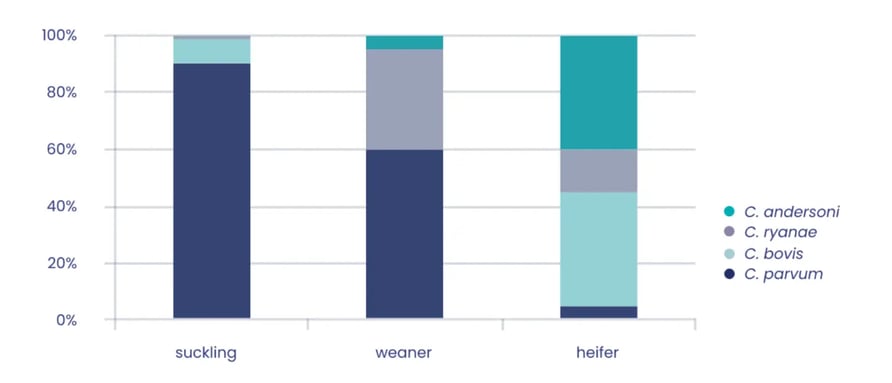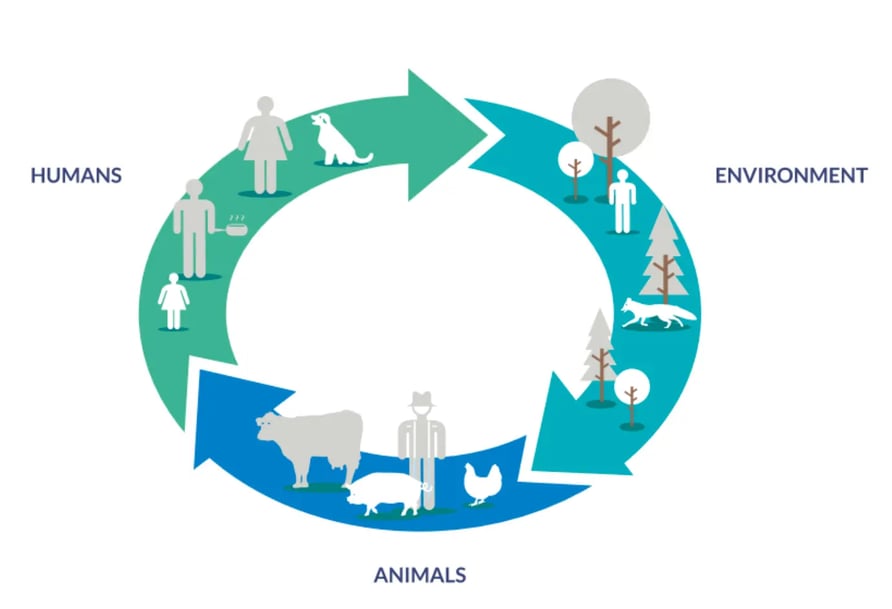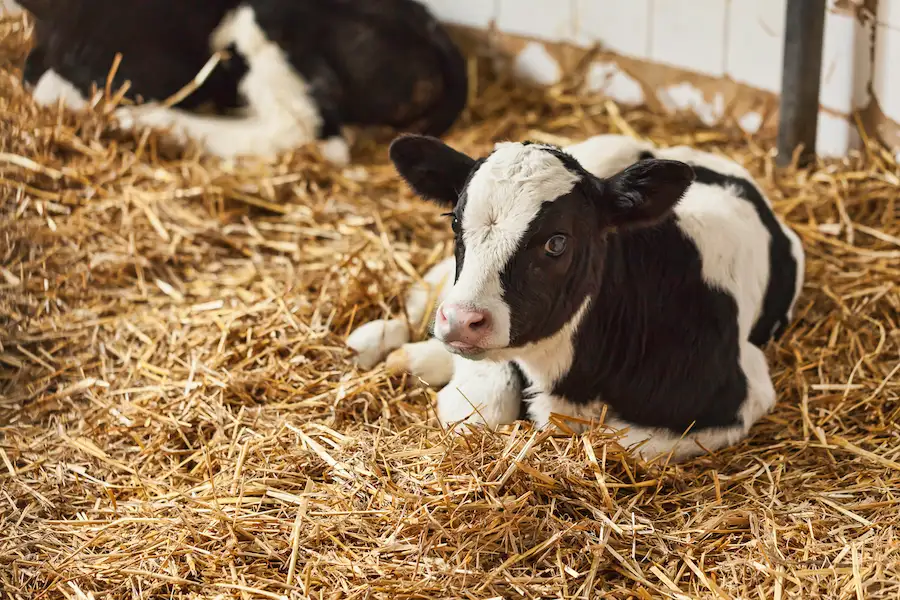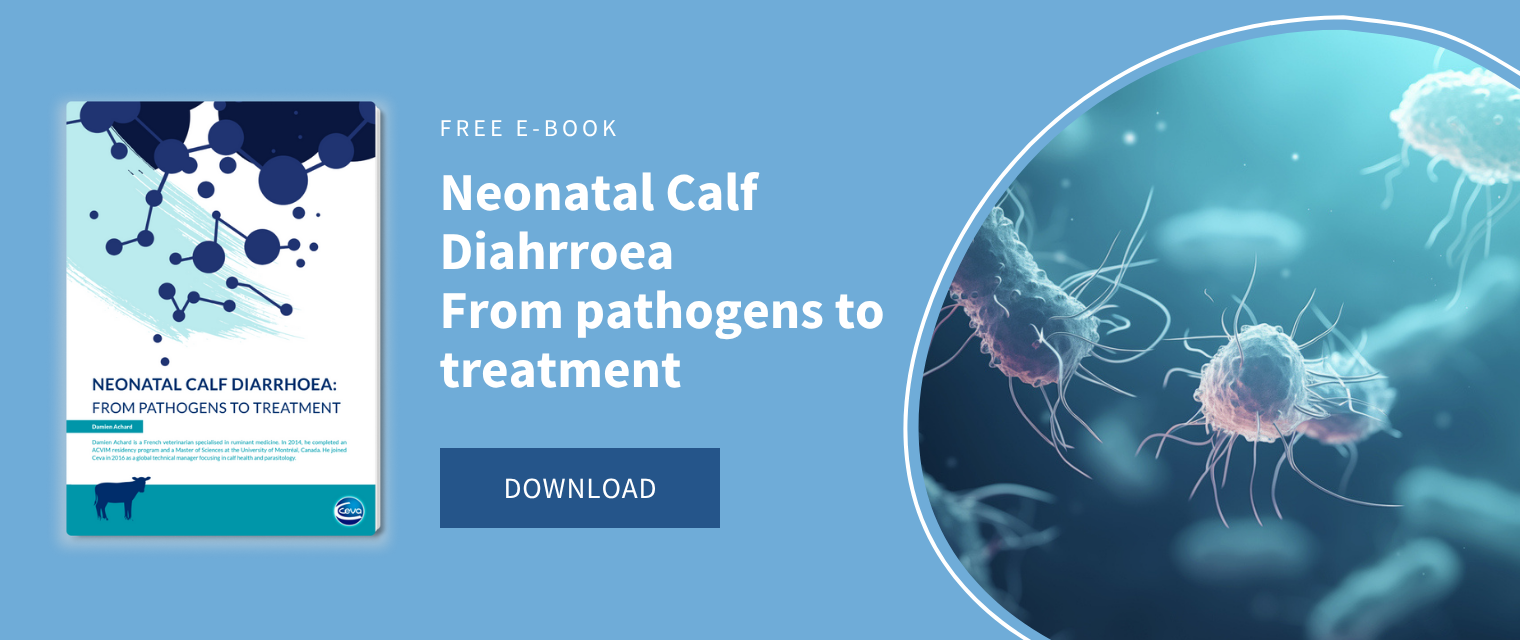Neonatal diarrhoea is the main infectious disease occurring within the first month of life of calves and its harmful effects extend until the first lactation. Of the various infectious agents that cause calf scours, cryptosporidiosis is probably the most important across European farms due to its prevalence, ubiquity, resistance in the environment, and low infective dose.
Cryptosporidiosis is a leading cause of neonatal calf diarrhoea
Among the germs inducing neonatal diarrhoea in calves, cryptosporidiosis caused by C. parvum is found in 36% to 71.99% of cases, both alone or in combination with other agents. As a sole agent, it is found in 18% to 52.6% of cases1-3. Therefore, cryptosporidiosis can be considered the main cause of neonatal diarrhoea in calves. This is due to several reasons:
- its scope of action ranging from 5 to 28 days of age ; in comparison, enterotoxigenic E. coli affects calves under 5-7 days, rotavirus under 15 and coronavirus under 21 days,
- crypto probably increases the severity and mortality of diarrhoea when associated with other viruses and bacteria,
- diarrhoeic calves usually excrete large numbers of oocysts (up to 107 oocysts per gram)
- the minimal infectious dose is very low, as few as 10 oocysts are needed to induce diarrhoea
- its long persistence in the environment due to its high resistance to climatic conditions and disinfectants4.

Cryptosporidiosis is highly prevalent in European calves
The prevalence of cryptosporidiosis in European farms is extremely high, from 90% to 100% of farms5-10, explaining why the disease can be considered endemic in Europe. Prevalence among calves is also high, with most of the studies reporting a prevalence of 20 to 40%1, 5, with some that exceed 70%2. While there are fewer studies in beef farms, the results are similar: 36.7% of calves can be considered infected in 97% of herds6. Organic farms are also affected by cryptosporidiosis. In Sweden, prevalence of cryptosporidiosis in calves was 44.7% in organic farms compared to 52.3% in conventional farms11. In France, a study recently reported that 40.2% of calves from 20 organic farms tested positive for C. parvum, like classically reared calves12. Varying figures can be found across studies. This is fundamentally due to differences in the sensitivity of the diagnostic method used and the age of the calves. The highest positive results are usually obtained when PCR methods are used in 1- to 3-week-old calves.

C. parvum is the dominant species in suckling calves
There are about 40 species of the genus Cryptosporidium, of which at least 4 are found in cattle13, 14, with C. parvum being predominantly detected in suckling calves and causing severe disease15. Although C. bovis, C. andersoni and C. ryanae have been identified in faeces of calves older than two months, their pathogenicity is low16,17. On the contrary, C. parvum is always identified in calves under one month of age and no longer, because immunity develops with age, except in immunocompromised animals.

Relative prevalence of Cryptosporidium spp. in calf producing farms in Germany15
Cryptosporidiosis caused by C. parvum is zoonotic and cattle are the main reservoir for human infection
Cryptosporidiosis is also an important cause of diarrhoea in humans, especially in children and chronic diarrhoea in immunocompromised adults18. In Europe, the infection is mainly acquired through recreational waters (in swimming pools, public paddling pools, water parks or open waters, as well as at mass sporting events involving water or mud) and contact with animals. C. parvum and C. hominis are responsible for most cases of cryptosporidiosis in people, with cattle representing an important reservoir for zoonotic subtypes of C. parvum. Transmission is faecal-oral, primarily by contact with calves or infected people, or can be airborne19, 20. In 2018, 11,418 confirmed cases of cryptosporidiosis were reported in 21 EU countries, with ratios per 100,000 population of 4.4 cases, rising to 15.8 in children under 4 years of age. The UK, Germany, the Netherlands, and Spain accounted for 76% of these cases and Belgium, Finland, Iceland, and the Netherlands report an increase in cases. The disease is probably underdiagnosed22.
Conclusions
Cryptosporidium parvum, the causative agent of calf cryptosporidiosis, is a major contributor to calf diarrhoea in Europe that is found in most calves and farms, regardless of the type of production: dairy, beef, intensive, extensive, conventional, or organic. In addition, cattle function as the reservoir of human cryptosporidiosis caused by C. parvum, which inflicts acute diarrhoea, especially in infants, and chronic diarrhoea in immunosuppressed patients. Because of the importance of cryptosporidiosis for human and animal health (One Health), its diagnosis and control in ruminant farms is essential.

Bibliographic references
1 Joachim A, Krull T, Schwarzkopf J, Daugschies A. Prevalence and control of bovine cryptosporidiosis in German dairy herds. Vet Parasitol. 2003;112(4):277-88.
2 de la Fuente R, Luzón M, Ruiz-Santa-Quiteria JA, García A, Cid D, Orden JA, García S, Sanz R, Gómez-Bautista M. Cryptosporidium and concurrent infections with other major enterophatogens in 1 to 30-day-old diarrheic dairy calves in central Spain. Vet Parasitol. 1999;80(3):179-85.
3 Thomson, S., Hamilton, C.A., Hope, J.C., Katzer, F., Mabbott, N.A., Morrison, L.J., & Innes, E.A. Bovine cryptosporidiosis: impact, host-parasite interaction and control strategies. Veterinary Research. 2017;48:42
4 Fayer, R., Graczyk, T.K., Cranfield, M.R., Trout, J.M. Gaseous disinfection of Cryptosporidium parvum oocysts. Appl. Environ. Microbiol. 1996; 62: 3908–3909.
5 Pinto P, Ribeiro CA, Hoque S, Hammouma O, Leruste H, Détriché S, Canniere E, Daandels Y, Dellevoet M, Roemen J, Barbier Bourgeois A, Kváč M, Follet J, Tsaousis AD. Cross-Border Investigations on the Prevalence and Transmission Dynamics of Cryptosporidium Species in Dairy Cattle Farms in Western Mainland Europe. Microorganisms. 2021; 9(11):2394.
6 Björkman C, Lindström L, Oweson C, Ahola H, Troell K, Axén C. Cryptosporidium infections in suckler herd beef calves. Parasitology. 2015;142(8):1108-14.
7 Chako CZ, Tyler JW, Schultz LG, Chiguma L, Beerntsen BT. Cryptosporidiosis in people: it's not just about the cows. J Vet Intern Med. 2010;24(1):37-43.
8 Sturdee AP, Bodley-Tickell AT, Archer A, Chalmers RM. Long-term study of Cryptosporidium prevalence on a lowland farm in the United Kingdom. Vet Parasitol 2003; 116:97–113.
9 Silverlås C, Emanuelson U, de Verdier K, Björkman C. Prevalence and associated management factors of Cryptosporidium shedding in 50 Swedish dairy herds. Prev Vet Med. 2009; 90(3-4):242-53.
10 Silverlås C, de Verdier K, Emanuelson U, Mattsson JG, Björkman C. Cryptosporidium infection in herds with and without calf diarrhoeal problems. Parasitol Res. 2010; 107(6):1435-44.
11 SILVERLÅS, C., & BLANCO-PENEDO, I. Cryptosporidium spp. in calves and cows from organic and conventional dairy herds. Epidemiology & Infection. 2013; 141(3), 529-539.
12 Constancis C, Ravinet N, Bernard M, Lehebel A, Brisseau N, Chartier C. Rearing system with nurse cows and risk factors for Cryptosporidium infection in organic dairy calves. Prev Vet Med. 2021;190:105321.
13 Pane, S.; Putignani, L. Cryptosporidium: Still Open Scenarios. Pathogens 2022; 11: 515.
14 Blanchard PC. Diagnostics of dairy and beef cattle diarrhea. Vet Clin North Am Food Anim Pract. 2012; 28:443–464
15 Lendner, M., Etzold, M., Daugschies, A (2011): Kryptosporidiose: ein update. Berl Münch Tierärztl Wschr 124 (11), 473-484
16 Hoque S, Pinto P, Ribeiro CA, Canniere E, Daandels Y, Dellevoet M, Bourgeois A, Hammouma O, Hunter P, Gentekaki E, Kváč M, Follet J, Tsaousis AD. Follow-up investigation into Cryptosporidium prevalence and transmission in Western European dairy farms. Vet Parasitol. 2023; 318:109920.
17 Santín M, Trout JM, Fayer R A. longitudinal study of cryptosporidiosis in dairy cattle from birth to 2 years of age. Vet Parasitol. 2008; 155:15–23.
18 Checkley,W.; White, A.C.; Jaganath, D.; Arrowood, M.J.; Chalmers, R.M.; Chen, X.-M.; Fayer, R.; Griffiths, J.K.; Guerrant, R.L.; Hedstrom, L.; et al. A Review of the Global Burden, Novel Diagnostics, Therapeutics, and Vaccine Targets for Cryptosporidium. Lancet Infect. Dis. 2015; 15: 85–94.
19 Putignani L, Menichella D. Global distribution, public health and clinical impact of the protozoan pathogen cryptosporidium. Interdiscip Perspect Infect Dis. 2010; 2010:753512.
20 Sponseller JK, Griffiths JK, Tzipori S. The evolution of respiratory Cryptosporidiosis: evidence for transmission by inhalation. Clin Microbiol Rev. 2014;27(3):575-86.
21 Slifko, T.R., Smith, H.V., Rose, J.B. Emerging parasite zoonoses associated with water and food. Int. J. Parasitol. 2000; 30: 1379–1393.
22 European Centre for Disease Prevention and Control. Cryptosporidiosis. In: ECDC. Annual epidemiological report for 2018. Stockholm: ECDC; 2021. https://www.ecdc.europa.eu/en/publications-data/cryptosporidiosis-annual-epidemiological-report-2018
About the author
Damien Achard (Ruminants Global Technical Manager)
Seasoned veterinarian, graduated from Ecole Nationale Vétérinaire de Nantes (France). After three years as a practitioner in central France, he pursued specialization in large animal internal medicine, completing an ACVIM residency and a Master of Sciences at the University of Montréal (2010-2014). Joining Semex Alliance as Health Manager for an IVF unit (2015-2016), he then transitioned to Ceva in 2016 as a Ruminants Global Technical Manager. Dr. Achard is an accomplished researcher, publishing on topics like downer cows, calf pneumonia or cryptosporidiosis and their associated therapies, and rational use of anthelmintics in ruminants. His ResearchGate profile (https://www.researchgate.net/profile/Damien-Achard/research) highlights his significant contributions to the veterinary field.
Explore author’s articles


Leave your comments here